Notes: West Brompton was a later addition, opening on 1st September 1866 following requests from local residents. Prior to opening the station was known as Brompton Road and then Richmond Road. At the same time the Metropolitan District Railway were planning to extend their line from Earls Court to an adjacent site on land owned by the WLER. There was disagreement between the two companies about who should design the station after the WLER board submitted their own plans for both stations.
By the time the station opened the name had been changed to West Brompton although it was sometimes referred to as West Brompton & Lillie Bridge.
| There was a street level building on the south side of Richmond Road (now Old Brompton Road) with covered stairways to the two platforms. The adjacent Metropolitan District station opened three years later on 12th April 1869 with its own entrance on Richmond Road. Initially the MDR station was a terminus until the line was extended to Putney Bridge on 1st March |
 |
1880 and then to Wimbledon on 3rd June 1889.
Although West Brompton was not a joint station they shared a platform building which served the northbound MD and the southbound WLER. Numerous improvements were made to the station over the years including the addition of a ladies waiting room in 1879.
In 1892 the LNWR opened the Brompton & Fulham goods depot on the west side of the line to the south of the station. The line into the goods depot utilised an original Kensington Canal bridge that had carried Richmond Road over the canal.
In 1908 the MDR suggested rebuilding the station as a single joint station but this was rejected by the WLER board much to the annoyance of the MDR. The scheme was again proposed in 1929 and once again it was rejected by the board who felt that they would lose out to the MDR who wanted to take control of the proposed new station. As part of the scheme the two separate entrances would have been demolished and replaced by a single entrance in a new parade of shops.
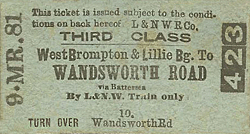 |
There was some light bomb damage to the station during WW2 and a bomb landed on the station during the night of 9/10th September 1940 but failed to explode. West Brompton closed along with the rest of the West London line on 21st October 1940. By the early 1950's the station was still intact but the street level building was in a dilapidated state. The platform |
buildings are believed to have been demolished in about 1952 with the street level building surviving until about 1957 leaving just its support girders which survived into the early 1970's.
Once the platform edge stones were removed in the early 1960's the remaining degraded platform mounds survived until the West London line was rejuvenated in the early 1990's. A new West Brompton Station was officially opened on the same site by Glenda Jackson on 1st June 1999 although trains started using the station two days earlier.
Following the closure of the Brompton & Fulham goods depot the track was lifted and the site cleared for redevelopment. A small plot of land on the south side of Lillie Road has been developed as a small nature reserve with a small pond. This includes the original Kensington canal bridge which is still extant.
Additional source: London's Disused Stations Volume 5 by J E Connor. Pub 2005 by Connor &
Butler. ISBN 0 947699 38 4
BRIEF HISTORY OF THE WEST LONDON LINE
As part of a general improvement of transport in West London, the Kensington Canal was opened on the 12th August 1828 running north from the Thames at Chelsea to a basin near Kensington.
| During the 1830's, the impending establishment of the London and Birmingham Railway (in 1833) and of the Great Western Railway (in 1835) was causing uncertainty about the future development of communications throughout west London. Neither company had yet decided upon the site for its permanent London terminus. But even before their |
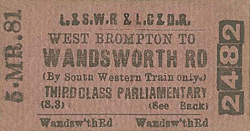 |
incorporation as a company the directors of the Great Western Railway had in 1834 considered building a goods terminus beside the Kensington Canal basin, giving them access by water to the London docks.
The Birmingham, Bristol & Thames Junction Railway was authorised by an Act of Parliament of June 1836 with powers to buy the canal and to build a railway northward to the London and Birmingham Railway at Willesden across the proposed route of the Great Western which opened to Bristol in 1838; thus creating a through route mainly for freight traffic from Bristol and Birmingham to the River Thames, the capital's main commercial artery. The directors of the new company expected the Great Western and the London & Birmingham to use their proposed new line as the most convenient route to the Thames. They also hoped the line would generate passenger revenue from the L & B and GWR if it was extended from their proposed southern terminus at Kensington to a new terminus near Hyde Park Corner, the gateway to London.
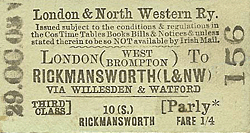 |
Construction started in 1836 with Sir William Hosking as engineer. The new line left the London & Birmingham Line at Willesden running south across the Great Western on the level where an interchange station was to be built with platforms on both lines. A further station was to be provided at Shepherds Bush before the line reached its southern passenger |
terminus at Kensington from where it passed under Hammersmith Road to a goods yard adjacent to the Kensington canal basin near Warwick Road.
Having purchased the ailing Kensington Canal Company for £36,000 the new company was itself in financial difficulty and a second Act of Parliament was required in 1840 to raise extra capital; at this time the company's name was shortened to the West London Railway. Trials to show-off the potential of the atmospheric railway system were held from 1840 to 1843 on a half-mile section of track adjacent to Wormwood Scrubs, leased to the system's promoters; but in the event, the line proceeded with conventional power.
The 2.5 mile single line officially opened between West London Junction, Willesden and Kensington on 27 May, 1844, with regular passenger services beginning on 10 June with a 30-minute interval service. By this time the L & B and GWR had chosen their London termini and were no longer interested in using the West London Railway. The terminus at Kensington was some distance from Kensington itself and any potential commuters, and the line ran through open country throughout; from the outset it was not a commercial success.
It is said that the first train had one passenger with little improvement in the following months. In September and October 1844 passenger receipts were only £15 10s per month and according to the company minutes of 25th October 1844 "The 5.55pm from Kensington was delayed so long at the crossing that it didn't reach West London Junction until 7pm and the solitary passenger had missed the last train to Harrow." The minimal level of passenger returns became such a regular target of Punch magazine that the line started being called Punch's Railway "leading from nowhere to nowhere". The company blamed the failure of the line on the refusal of the L & B and GWR to stop their to stop their long distance trains at the respective junctions with the West London and with losses of £50 per week the line was forced to close after the last train on 30 November 1844 after less than six months.
| An Act of 1845 authorised the Great Western and the London and Birmingham to take out a joint lease of the West London Railway in 1846 but passenger services were not restarted and the line was only used to carry coal. On 31st July 1854 the company was vested jointly in the London & North Western Railway and the Great Western Railway. The rubbish-strewn |
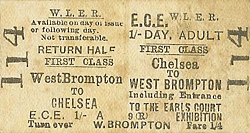 |
Kensington Canal was soon to prove a millstone with the company’s single locomotive often having to cope with foul flood water at high tide. Following an outbreak of cholera caused by the stagnant water, a further Act in 1859 allowed the companies to fill in the canal from the Kensington basin as far south as the bridge under the Kings Road and to construct the West London Extension Joint Railway which was formed by Act of Parliament on 15th August 1859 to meet the lines south of the river to a junction with the London & South Western Railway and the London Brighton & South Coast Railway at Clapham Junction. The WLER was a joint venture between the LNWR, GWR, LSWR and LBSCR with the latter two companies holding one third of the capital between them.
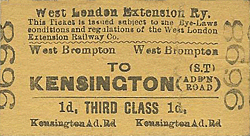 |
Another source of problems for the line was the flat junction with the Great Western south of Willesden with a number of serious collisions taking place at the level crossing. This was eventually overcome by realigning the West London Line over the Great Western to the west of the crossing; this was brought into use in October 1860. |
The northern end of the Kensington Canal was infilled in 1861 with much of its course being used for the WLER. The new double track line between Willesden and Clapham Junction opened to passenger traffic on 2 March 1863. Kensington & Shepherds Bush (renamed Uxbridge Road) stations were rebuilt a little to the south of the original sites with new stations provided at Chelsea and Battersea and a further station opening at West Brompton on 1st September 1866. A third rail was laid to allow broad gauge trains to use the extension but this had limited use with broad gauge passenger trains running into Victoria until October 1866 and freight trains running to Chelsea Basin until November 1875.
Unlike its predecessor, the West London Joint Railway as it became known, was an immediate success. A spur from the Hammersmith & City line at Latimer Road opened on the 13th July 1864 which gave Great Western trains direct access to the line from the London direction. On 1st January 1869, the London & South Western Railway opened a line from Richmond to a junction with the West London line just north of Kensington Station and on the 12th April 1869 a connection between the West London Line and the District Railway was made at West Brompton and a northbound spur from the District Railway to Kensington was opened on 1st February 1872. There was also a connection to the District Railways Lillie Bridge Depot. On 1st June 1877 the District Railway was extended a short distance west from its station at Hammersmith to a junction with the 1869 LSWR's Richmond Branch.
The new multiplicity of connections led to considerable development of transfer freight traffic between the northern and southern lines while the former also opened depots south of the river. In spite of the equivalent possibilities for through passenger traffic, this didn't begin until 1904 and never attracted the expected passenger revenue.
| The first section of the West London Line to be electrified was between the Latimer Road spur and Kensington in 1909 allowing Metropolitan trains to reach Kensington. Further electrification took place in 1914 when LNWR trains ran into Earls Court. On 16th April 1917 the GWR opened a link between its Birmingham line and the North London line at North |
 |
Acton although this was used mainly for freight traffic.
During the 1923 Grouping the West London Railway nominally retained its independence although the West London Extension Railway was absorbed.
Despite the early heavy passenger numbers use of the line dwindled with the construction of the deep-level underground network and the introduction of trams and motor busses which provided a quicker and more convenient route for commuters to reach central London. Local north-south passengers also deserted the line in favour of road transport. WW2 hastened the demise of the now uneconomic passenger services. Following severe bomb damage, the advertised steam services from Clapham Junction - Kensington ceased on 20th October 1940 and the electric services, LMSR from Willesden and LT now from Edgware Road on 3rd and 20th October respectively.
 |
The line remained in service as an important freight link. After the war only the short section of line between Kensington and Earls Court was reopened for passenger traffic with the service being provided by London Transport’s District Line from 19th December 1946, but only when there was an exhibition at Olympia. A workmen's steam hauled passenger |
service ran between Clapham Junction and Kensington with two trains in the morning rush hour and two in the evening. With the closure of Nine Elms depot in 1967 diesels took over the service. This service received little promotion and most people were unaware of its existence. Most of the conductor rails between Kensington and Willesden were removed between 1946 - 1952.
The line remained busy with 30 freight trains in each direction daily and holiday excursions and special cross country workings were common. On 24th May 1966 the West London Line received a new lease of life with the opening of the Motorail terminal at Kensington, with car-transport services to a wide range of destinations in Scotland, Wales and the West Country. These services ceased in 1988 and the Motorail terminal closed. It’s now used as a covered car-park and the reception area is now the booking hall and ticket office.
| Despite this set back for the line, a renaissance began in 1986 when the District Line recommenced a full service, joined in 1994 by a rejuvenated service on the West London Line, from Willesden Junction to Clapham Junction and from Watford Junction to Brighton. A new station was opened at West Brompton on the site of the original station on 30th |
 |
May 1999. A further new station at Shepherds Bush opened on the site of the former Uxbridge Road Station on 28th September 2008 and a third new station called Imperial Wharf on a new site between the old Chelsea & Fulham and Battersea stations is currently under construction and is due to open in late 2009.
The line is electrified at 750 V DC third rail from the south to the North Pole depot, where the electrification changes to 25 kV AC overhead. The work was carried out as part of Channel Tunnel infrastructure improvements in 1993.
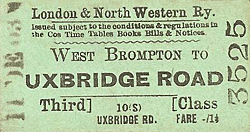 |
Local trains run every half hour and are operated by London Overground. Hourly Southern trains run between East Croydon (formerly Brighton) and Milton Keynes (previously Watford Junction), not stopping at Willesden Junction. The twice daily cross country services from Brighton to Birmingham New Street via Reading was discontinued in December 2008. |
The line still carries considerable freight traffic and was used by Eurostar trains between Waterloo International and the depot at North Pole Junction prior to November 2007. Recent timetable changes have meant that some London Overground peak hour trains now continue beyond Willesden Junction onto the North London Line to Stratford.
Tickets from Michael Stewart, Bradshaw from Chris Hind
Sources:
Click on the station name to see other stations on the West London Line:
Clapham Junction STILL OPEN, Battersea, Imperial Wharf NEW STATION, Chelsea & Fulham, Kensington (1st site), Kensington (1st site), Kensington Olympia STILL OPEN, Uxbridge Road REOPENED AS SHEPHERDS BUSH 3rd SITE, Shepherds Bush (1st site), Shepherds Bush(2nd site), St. Quintin Park & Wormwood Scrubbs (1st site), St. Quintin Park & Wormwood Scrubbs (2nd site), West London Junction (1),
West London Junction (2), Willesden Junction STILL OPEN
See also Hammersmith (Grove Road) & Shepherds Bush on the
Richmond - Kensington line |

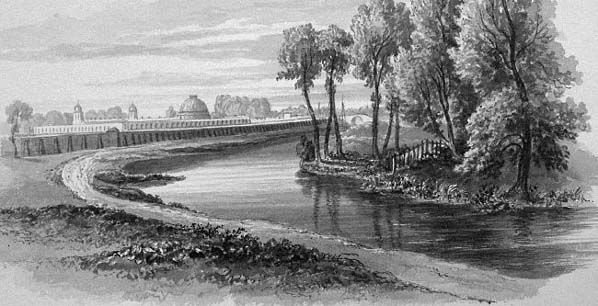


brompton_old1.jpg)
brompton_old5.jpg)
brompton_old7.jpg)
brompton1.jpg)
brompton2.jpg)
brompton13.jpg)
brompton12.jpg)
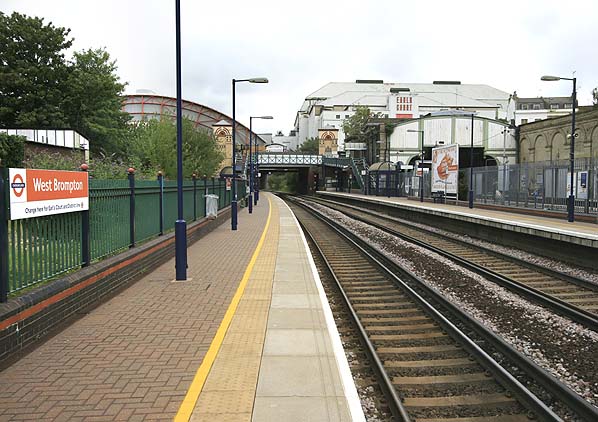




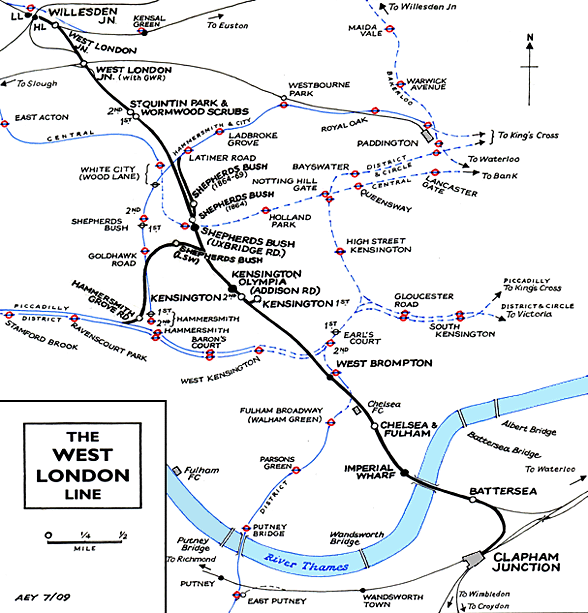







brompton_old_thumb8.jpg)
brompton_old_thumb6.jpg)
brompton_old_thumb4.jpg)
brompton_old_thumb2.jpg)
brompton_old_thumb3.jpg)
brompton_thumb2.jpg)
brompton_thumb1.jpg)
brompton_thumb3.jpg)
brompton_thumb4.jpg)







 Home Page
Home Page